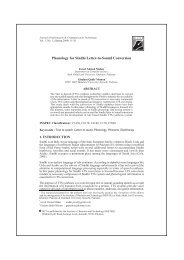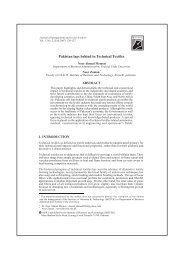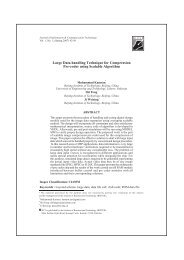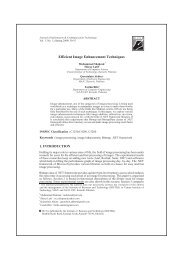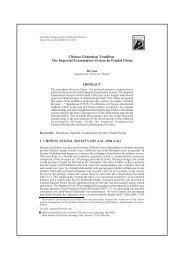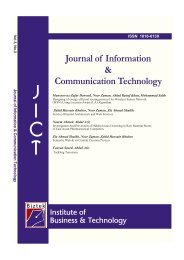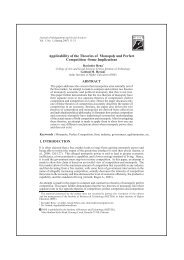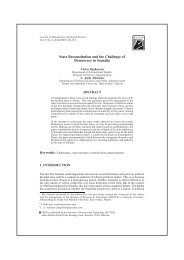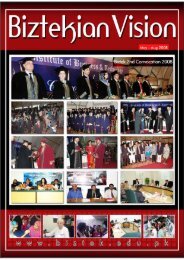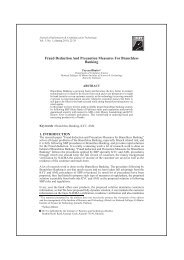Energy Efficient Protocol Design Issues in Wireless Sensor Networks
Energy Efficient Protocol Design Issues in Wireless Sensor Networks
Energy Efficient Protocol Design Issues in Wireless Sensor Networks
- No tags were found...
Create successful ePaper yourself
Turn your PDF publications into a flip-book with our unique Google optimized e-Paper software.
Journal of Information & Communication TechnologyVol. 4, No. 1, (Spr<strong>in</strong>g 2010) 12-18<strong>Energy</strong> <strong>Efficient</strong> <strong>Protocol</strong> <strong>Design</strong> <strong>Issues</strong> <strong>in</strong> <strong>Wireless</strong> <strong>Sensor</strong><strong>Networks</strong>Abdul Raouf Khan*Department of Computer SciencesK<strong>in</strong>g Faisal University, Saudi ArabiaABSTRACT<strong>Sensor</strong> networks consist of a large number of small, <strong>in</strong>expensive sensor nodes.These nodes have small batteries with limited power and also have limitedcomputational power and storage space. When the battery of a node is exhausted,it is not replaced and the node dies. When sufficient number of nodes die, thenetwork may not be able to perform its designated task. Thus the life time of anetwork is an important characteristic of a sensor network and it is tied up withthe life time of a node. This paper presents a survey for design<strong>in</strong>g energy efficient<strong>Wireless</strong> <strong>Sensor</strong> Network (WSN) <strong>Protocol</strong>s and identifies future trends <strong>in</strong>design<strong>in</strong>g energy efficient WSN protocols.Keywords : WSN, <strong>Energy</strong> efficient protocol, WSN design issues1. OVERVIEW OF WIRELESS SENSOR NETWORKSThe recent development of small wireless sens<strong>in</strong>g devices has opened the door for severalnew applications. These applications have the potential <strong>in</strong> chang<strong>in</strong>g the way we perceive,monitor, and <strong>in</strong>teract with the physical world. Many application doma<strong>in</strong>s have alreadybeen mentioned <strong>in</strong> the literature [1, 2, 3, 4, 5, 6]. For example, sensor nodes can be deployed<strong>in</strong> the battlefield to monitor and track the enemy's troop movement (i.e., military applications).<strong>Sensor</strong> nodes can also provide attractive solutions for challeng<strong>in</strong>g medical problems; forexample, small bio-sensors can function as an artificial ret<strong>in</strong>a that replaces a damaged one[3] when deployed <strong>in</strong>side the human body. Environmental monitor<strong>in</strong>g is another promis<strong>in</strong>gapplication doma<strong>in</strong> for wireless sensor networks. For example, wireless sensor networkscan be used to monitor pollution levels <strong>in</strong> water resources and soil. Also, wireless sensornetworks can be used to track and monitor volcanic and earthquake activities, this allowsfor the early detection of any activities, which helps <strong>in</strong> avoid<strong>in</strong>g or at least mitigat<strong>in</strong>gdisasters. Like <strong>in</strong> out-door applications, WSNs have many promis<strong>in</strong>g <strong>in</strong>-door applications.For example, WSNs can be deployed <strong>in</strong> the apartments of elderly people provid<strong>in</strong>g an<strong>in</strong>novative non-obtrusive tool to better monitor the activities of elders liv<strong>in</strong>g <strong>in</strong> theirapartments. In this capacity, WSNs facilitate connect<strong>in</strong>g seniors to their caregivers and thecommunication of any emergency conditions such as fall<strong>in</strong>g of the elder.* The material presented by the authors does not necessarily portray the viewpo<strong>in</strong>t of the editorsand the management of the Institute of Bus<strong>in</strong>ess and Technology (Biztek) or K<strong>in</strong>g Faisal University, SaudiArabia.C* Abdul Raouf Khan : raoufkhan@kfu.edu.saraouf_ark@yahoo.comJICT is published by the Institute of Bus<strong>in</strong>ess and Technology (Biztek).Ibrahim Hydri Road, Korangi Creek, Karachi-75190, Pakistan.
<strong>Energy</strong> <strong>Efficient</strong> <strong>Protocol</strong> <strong>Design</strong> <strong>Issues</strong> <strong>in</strong> <strong>Wireless</strong> <strong>Sensor</strong> <strong>Networks</strong>Environmental monitor<strong>in</strong>g is one of the earliest envisioned applications of wireless sensornetworks. Therefore, research challenges of this particular application caught the attentionof many researchers, which resulted <strong>in</strong> a large body of work. In this application, researchersenvision large scale deployment, where a large number of sensor nodes are scattered <strong>in</strong>the sensor field. After deployment, these nodes should organize among themselves andform a multi-hop network and should rema<strong>in</strong> functional for long time periods, severalyears <strong>in</strong> some applications [1, 4]. By functional, we mean that the network should be ableto perform the orig<strong>in</strong>al job the network is supposed to do, e.g., sens<strong>in</strong>g the environmentand send<strong>in</strong>g the results back to some base station. S<strong>in</strong>ce the lifetime of <strong>in</strong>dividual sensornodes is usually on the order of a few months, and that it is <strong>in</strong>feasible to re-power <strong>in</strong>dividualnodes by simply chang<strong>in</strong>g their battery, techniques to save the power consumption and soextend the lifetime of wireless sensor networks is vital <strong>in</strong> real life applications and havebeen extensively studied <strong>in</strong> the literature.Researchers have considered several techniques to decrease power consumption at thedifferent layers. At the application level, aggregation [7, 8, 9], where multiple data messagesare diffused and <strong>in</strong>tegrated <strong>in</strong>to a s<strong>in</strong>gle data message, is one of the techniques used tolower the power consumption spent on transmitt<strong>in</strong>g redundant data messages from the datasources back to the s<strong>in</strong>k. Several energy-aware rout<strong>in</strong>g protocols [10, 11, 12, 13, 14] havebeen discussed <strong>in</strong> the literature. In these protocols the current power level of the sensornode is considered by the rout<strong>in</strong>g protocol as a criteria <strong>in</strong> choos<strong>in</strong>g routes between sourcesand dest<strong>in</strong>ations. Trad<strong>in</strong>g off network delay to power consumption was leveraged by MACprotocols to <strong>in</strong>troduce low duty cycle operation modes, where nodes turn their radios offif not actively transmitt<strong>in</strong>g or receiv<strong>in</strong>g [15, 16, 17, 18].Like other network protocols, topology control was used as yet another attempt to extendthe network lifetime and reduce power consumption. The term "topology control" has beenused <strong>in</strong> the literature <strong>in</strong> two contexts, some people [19, 20, 21, 22, 23, 24, 25] use the termto refer to the problem of adjust<strong>in</strong>g the transmission power of the sensor nodes and soadjust<strong>in</strong>g the network topology, while others [2, 26, 27, 28, 29, 16, 30, 31, 32, 33] usethe term to describe the process of turn<strong>in</strong>g the sensor nodes radio on and off consequentlycontroll<strong>in</strong>g the network topology and decrease total power consumption. We refer to thelatter as the node schedul<strong>in</strong>g technique.In node schedul<strong>in</strong>g protocols [2, 26, 27, 28, 29, 16, 30, 31, 32, 33], node redundancy wasexploited to extend the network lifetime. The key idea <strong>in</strong> this class of protocols is to identifynode redundancy <strong>in</strong> terms of some functionality (usually communication), cluster redundantnodes together, and f<strong>in</strong>ally schedule nodes <strong>in</strong> the clusters for active or sleep modes <strong>in</strong> sucha way the network is able to perform the orig<strong>in</strong>al function adequately. Although all topologycontrol protocols that fall <strong>in</strong> this category share the basic idea, the exact node redundancydef<strong>in</strong>ition and criteria for a node to stay active or switch to sleep are still the property ofa specific node schedul<strong>in</strong>g protocol.2. ENERGY EFFICIENCY DESIGN OF WSN<strong>Energy</strong> efficiency is always one of the major goals <strong>in</strong> the design of WSN. <strong>Energy</strong> efficientprotocols have been explored for a long time. Previous work expects to achieve the goalof energy efficiency by design<strong>in</strong>g energy efficient query protocols [44], rout<strong>in</strong>g protocols,such as [10, 11,12,13,29,32], energy efficient MAC protocols like [10, 17], energy efficientcluster<strong>in</strong>g and duty cycle management [7,14], sensor network topology management [30],and other energy efficient approaches [11, 12, 13, 15, 16, 17]. However, these approachesma<strong>in</strong>ly focus on f<strong>in</strong>d<strong>in</strong>g some energy efficient path, design<strong>in</strong>g better turn on/off schedules,form<strong>in</strong>g energy efficient clusters, and so on, but none of them has exam<strong>in</strong>ed the energyefficiency from the view of the data itself, i.e., to adapt the data sampl<strong>in</strong>g rate to the datadynamics and keep lazy when data consistency is ma<strong>in</strong>ta<strong>in</strong>ed.Vol. 4, No. 1, (Spr<strong>in</strong>g 2010) 13
Abdul Raouf KhanAggregation is one of the most common technologies used <strong>in</strong> wireless sensor networksto save energy. Aggregation structures such as TAG [7, 8] are designed to aggregate themessage. Another work from [11] propose new aggregation scheme that significantlyextends the class of queries that can be answered us<strong>in</strong>g sensor networks. In [45]also useaggregation scheme used, not only take advantage of the earlier aggregation techniquesbut also tried to comb<strong>in</strong>e several pieces of data together.Load balanced protocols are designed <strong>in</strong> different layer of sensor systems to save energyand extend the lifetime of wireless sensor networks. Dai and Han <strong>in</strong> [31] construct a loadbalanced tree <strong>in</strong> the sensor networks to make the load evenly distribute to different branchesof the rout<strong>in</strong>g tree. Indirectly Query [48] is proposed to balance the load at query layerso that it extends the lifetime of WSN a lot. At the higher level, several researchers haveproposed to balance the load of sensors by rotat<strong>in</strong>g their functionality, <strong>in</strong>clud<strong>in</strong>g coord<strong>in</strong>ators<strong>in</strong> topology management [29], rotation of grid zone headers <strong>in</strong> GAF rout<strong>in</strong>g [32], rotat<strong>in</strong>gcluster headers <strong>in</strong> hierarchical protocols [47], and switch<strong>in</strong>g among multi-paths dur<strong>in</strong>grout<strong>in</strong>g [46].<strong>Energy</strong> aware rout<strong>in</strong>g is also used to save energy and extend the lifetime of wireless sensornetworks. Shah and Rabaey proposed an energy aware protocol [13]. They kept us<strong>in</strong>g aset of good paths <strong>in</strong>stead of just f<strong>in</strong>d<strong>in</strong>g a s<strong>in</strong>gle optimal path and used different path atdifferent time with some probability depend<strong>in</strong>g on the energy metric. Younis et al. [14]designed an energy-aware rout<strong>in</strong>g for cluster-based sensor network. In their approach, thegateway <strong>in</strong> each cluster applies energy-aware metrics to manage the topology adjustmentand rout<strong>in</strong>g setup, but the cluster based scheme is argued to be energy <strong>in</strong>efficient. GEAR[32] and WEAR [44] are both used as energy aware approaches to balance the load todifferent sensors so that they extend the lifetime of WSN significantly.Duty cycle management and sensor network topology management are two other approachesto achieve the goal of energy efficiency. In [7,14], the authors tried to design an on/offschedule for sensors so that they can save energy by mak<strong>in</strong>g sensors sleep as much aspossible. Gupta proposed a topology management mechanism <strong>in</strong> sensor networks to saveenergy [30]. The basic idea of this approach is to take advantage of the redundant sensors.To be specific, they pick up a set of sensors from the sensor network and make sure thatthis set of sensors are sufficient to reconstruct data for the entire sensor networks. Thisapproach can save energy but it also <strong>in</strong>troduce load imbalance, and it cannot satisfy someapplications that require a certa<strong>in</strong> level of data redundant. In general, data quality managementscheme complements this k<strong>in</strong>d of approaches very well by consider<strong>in</strong>g both energyefficiency and data quality.3. NODE SCHEDULING PROTOCOLSWork on node schedul<strong>in</strong>g protocols is widely diverse; its evolution, over the last five tosix years, is divided <strong>in</strong>to three stages. The bulk of the work <strong>in</strong> the first stage is puretheoretical analysis of the m<strong>in</strong>imum connected dom<strong>in</strong>at<strong>in</strong>g set problem. Centralizedoptimization algorithms are proposed to select the m<strong>in</strong>imum connected dom<strong>in</strong>at<strong>in</strong>g set[34, 35, 36], which is known to be an NP-hard problem. This work lacked the practicalitywhich prevented its applicability <strong>in</strong> real life sensor network deployments. The reportedsensor node wireless transceiver module power consumption profile made the nodeschedul<strong>in</strong>g approach, among others, more appeal<strong>in</strong>g <strong>in</strong> extend<strong>in</strong>g the network lifetime,therefore it triggered new <strong>in</strong>terest <strong>in</strong> the topic. In the second stage, researchers shifted theirefforts to address the more practical issues of wireless communication l<strong>in</strong>ks and <strong>in</strong>vestigatelocalized fully distributed algorithms to select the active node set [2, 26, 27, 28, 29, 16,30, 31, 32, 33 ]. The primary goal of the node schedul<strong>in</strong>g protocols <strong>in</strong> this stage is to selectthe optimal active node set that most extends the network lifetime, other network propertiessuch as reliability, network capacity, and coverage are ignored. Propos<strong>in</strong>g new nodeschedul<strong>in</strong>g algorithms was not the primary concern <strong>in</strong> the third stage. Instead, researchers14 Journal of Information & Communication Technology
<strong>Energy</strong> <strong>Efficient</strong> <strong>Protocol</strong> <strong>Design</strong> <strong>Issues</strong> <strong>in</strong> <strong>Wireless</strong> <strong>Sensor</strong> <strong>Networks</strong>shifted their efforts aga<strong>in</strong> to study and <strong>in</strong>vestigate assumptions made <strong>in</strong> the second stage,such as the assumption that sparse networks improve network capacity. Furthermore, faulttolerance and coverage are considered as important network properties <strong>in</strong> addition to bareconnectivity [19, 37, 38, 39, 40, 41, 42].4. FUTURE COURSE OF ACTIONS<strong>in</strong>ce its conception, <strong>Wireless</strong> <strong>Sensor</strong> <strong>Networks</strong> (WSNs) have been envisioned to operateautonomously for long period of time and without close supervision and human <strong>in</strong>tervention.This key requirement demands that WSNs <strong>in</strong>corporate features such as self-configuration,self-organization, and dependability. Self-configuration and self-organization requires thedevelopment of adequate system-level support that enables the sensor nodes to automaticallyand cont<strong>in</strong>uously discover its surround<strong>in</strong>gs, <strong>in</strong>clud<strong>in</strong>g its neighbors and topology <strong>in</strong>formation,and to organize <strong>in</strong>to a connected network. On the other hand, node failures should notrender the WSN non operational. In other words, the WSN should be able to withstandnode failures and heal on its own and without external <strong>in</strong>tervention. Further, <strong>in</strong>vestigationscan be done to develop energy efficient WSN network protocols that move WSNs forwardtoward implement<strong>in</strong>g this vision (i.e., autonomous dependable WSNs).This can be planned <strong>in</strong> two major ways. First, by us<strong>in</strong>g analytical models to formalizeand quantify WSN dependability characteristics. These models may allow for the systematic<strong>in</strong>tegration of WSN dependability as a primary dimension <strong>in</strong> the design space of thecommunication stack protocols and algorithms as well as the deployment problem. Perhapsthe most prevalent node failures are those caused by harsh environmental conditions.Therefore, focus shall be on WSNs reliability and availability aspects of dependability.Second, WSNs are believed to be application-specific. Different applications imposedifferent requirements and even different research challenges. Furthermore, different WSNapplication environments yield different sensor node failure models, which imply differentWSN reliability behavior and mandate different algorithms from the reliability po<strong>in</strong>t ofview. Therefore, an application driven approach can be followed <strong>in</strong> protocol design.Various applications can be targeted such as large-scale environmental applications withirregular and random sensor node placement, <strong>in</strong>-door mission-critical applications, andenvironmental application with uniform l<strong>in</strong>ear sensor node placement.5. CONCLUSIONIn this paper, we made an attempt to summarize the results of major contributions ofvarious researchers <strong>in</strong> the field of wireless sensor networks. Based on that, we tried toidentify the future areas of work particularly <strong>in</strong> design of energy efficiency protocols.REFERENCES[1] S. Al-Omari, W. Shi, and C. J. Miller. Sesame: A sensor system access<strong>in</strong>g andmonitor<strong>in</strong>g environment. Technical Report MIST-TR-2004-018, Wayne StateUniversity, Nov. 2004.[2] W. Steven Conner, Jasmeet Chhabra, Mark Yarvis, and Lakshman Krishnamurthy.Experimental evaluation of synchronization and topology control for <strong>in</strong>-build<strong>in</strong>gsensor network applications. In WSNA '03: Proceed<strong>in</strong>gs of the 2nd ACM <strong>in</strong>ternationalconference on <strong>Wireless</strong> sensor networks and applications, pages 38-49,NY, USA,2003. ACM Press.[3] Loren Schwiebert, Sandeep K.S. Gupta, and Jennifer We<strong>in</strong>mann. Research challenges<strong>in</strong> wireless networks of biomedical sensors. In MobiCom '01: Proceed<strong>in</strong>gs of the 7thannual <strong>in</strong>ternational conference on Mobile comput<strong>in</strong>g and network<strong>in</strong>g, pages 151-165, New York, NY, USA, 2001. ACM Press.[4] W. Shi and C. Miller. Waste conta<strong>in</strong>ment system monitor<strong>in</strong>g us<strong>in</strong>g wireless sensornetworks. Technical Report MIST-TR-2004-009, Wayne State University, March2004.Vol. 4, No. 1, (Spr<strong>in</strong>g 2010) 15
Abdul Raouf Khan[5] R. Szewczyk, A. Ma<strong>in</strong>war<strong>in</strong>g, J. Polastre, and D. Culler. An analysis of a large scalehabitat monitor<strong>in</strong>g application. In Proc. of ACM SenSys 2004, November 2004.[6] Pei Zhang, Christopher M. Sadler, Stephen A. Lyon, and Margaret Martonosi.Hardware design experiences <strong>in</strong> zebranet. In SenSys '04: Proceed<strong>in</strong>gs of the 2nd<strong>in</strong>ternational conference on Embedded networked sensor systems, pages 227-238,New York, NY, USA, 2004. ACM Press.[7] K. Dasgupta et al. An efficient cluster<strong>in</strong>g-based heuristic for data gather<strong>in</strong>g andaggregation <strong>in</strong> sensor networks. In Proceed<strong>in</strong>gs of the IEEE <strong>Wireless</strong> Communicationsand Network<strong>in</strong>g Conference (WCNC'03), March 2003.[8] S. Madden, M. J. Frankl<strong>in</strong>, J. Hellerste<strong>in</strong>, and W. Hong. Tag: A t<strong>in</strong>y aggregationservice for ad-hoc sensor network. In Proc. of the Fifth USENIX Symposium onOperat<strong>in</strong>g Systems<strong>Design</strong> and Implementation, December 2002.[9] S. Nath et al. Synopsis diffusion for robust aggregration <strong>in</strong> sensor networks. In Proc.of ACM SenSys 2004, November 2004.[10] B. Hamdaoui and P. Ramanathan. <strong>Energy</strong>-<strong>Efficient</strong> and MAC-Aware Rout<strong>in</strong>g forData Aggregation <strong>in</strong> <strong>Sensor</strong> <strong>Networks</strong>. IEEE Press, October 2004.[11] C. Schurgers and M.B. Srivastava. <strong>Energy</strong> efficient rout<strong>in</strong>g <strong>in</strong> wireless sensor networks.In MILCOM Proceed<strong>in</strong>gs on Communications for Network-Centric Operations:Creat<strong>in</strong>g the Information Force, 2001.[12] K. Seada, M. Zuniga, A. Helmy, and B. Krishnamachari. <strong>Energy</strong>-efficient forward<strong>in</strong>gstrategies for geographic rout<strong>in</strong>g <strong>in</strong> lossy wireless sensor networks. In Proc. of ACMSenSys 2004, November 2004.[13] R. Shah and J. Rabaey. <strong>Energy</strong> aware rout<strong>in</strong>g for low energy ad hoc sensor networks.In Proceed<strong>in</strong>gs of the IEEE <strong>Wireless</strong> Communications and Network<strong>in</strong>g Conference(WCNC'02), March 2002.[14] M. Younis, M. Youssef, and K. Arisha. <strong>Energy</strong>-aware rout<strong>in</strong>g <strong>in</strong> cluster-based sensornetwork. In Proceed<strong>in</strong>gs of ACM/IEEE MASCOTS'2002, October 2002.[15] S. Jayashree, B. S. Manoj, and C. Siva Ram Murthy. On us<strong>in</strong>g battery state formedium access control <strong>in</strong> ad hoc wireless networks. In MobiCom '04: Proceed<strong>in</strong>gsof the 10th annual <strong>in</strong>ternational conference on Mobile comput<strong>in</strong>g and network<strong>in</strong>g,pages 360-373, New York, NY, USA, 2004. ACM Press.[16] C. Schurgers et al. Topology management for sensor networks: exploit<strong>in</strong>g latencyand density. In Proceed<strong>in</strong>gs of the MobiHoc'02, June 2002.[17] W. Ye, J. Heidemann, and D. Estr<strong>in</strong>. An energy-efficient mac protocol for wirelesssensor networks. In Proceed<strong>in</strong>gs of IEEE Infocom'02, New York, NY, June 2002.[18] Rong Zheng, Jennifer C. Hou, and Lui Sha. Asynchronous wakeup for ad hocnetworks. In MobiHoc '03: Proceed<strong>in</strong>gs of the 4th ACM <strong>in</strong>ternational symposiumon Mobile ad hoc network<strong>in</strong>g & comput<strong>in</strong>g, pages 35-45, New York, NY, USA, 2003.ACM Press.[19] Christian Bettstetter. On the m<strong>in</strong>imum node degree and connectivity of a wirelessmultihop network. In Proceed<strong>in</strong>gs of the MobiHoc'02, June 2002.[20] Errol L. Lloyd, Rui Liu, Madhav V. Marathe, Ram Ramanathan, and S. S. Ravi.Algorithmic aspects of topology control problems for ad hoc networks. Mob. Netw.Appl., 10(1-2):19-34, 2005.[21] MohammadTaghi Hajiaghayi, Nicole Immorlica, and Vahab S.Mirrokni. Poweroptimization <strong>in</strong> fault-tolerant topology control algorithms for wireless multi-hopnetworks. In MobiCom'03: Proceed<strong>in</strong>gs of the 9th annual <strong>in</strong>ternational conferenceon Mobile comput<strong>in</strong>g and network<strong>in</strong>g, pages 300-312, New York, NY, USA, 2003.ACM Press.[22] Li Li, Joseph Y. Halpern, Paramvir Bahl, Yi-M<strong>in</strong> Wang, and Roger Wattenhofer. Aconebased distributed topology-control algorithm for wireless multi-hop networks.IEEE/ACM Trans. Netw., 13(1):147-159, 2005.[23] N. Li and J. Hou. Topology control <strong>in</strong> hetergeous wireless networks: Problems andsolutions. In Proc. of IEEE Conference on Computer Communications (INFOCOM'04),March 2004.[24] Errol L. Lloyd, Rui Liu, Madhav V. Marathe, Ram Ramanathan, and S. S. Ravi.Algorithmic aspects of topology control problems for ad hoc networks. Mob. Netw.16 Journal of Information & Communication Technology
<strong>Energy</strong> <strong>Efficient</strong> <strong>Protocol</strong> <strong>Design</strong> <strong>Issues</strong> <strong>in</strong> <strong>Wireless</strong> <strong>Sensor</strong> <strong>Networks</strong>Appl., 10(1-2):19-34, 2005.[25] Paolo Santi, Douglas M. Blough, and Feodor Va<strong>in</strong>ste<strong>in</strong>. A probabilistic analysis forthe range assignment problem <strong>in</strong> ad hoc networks. In MobiHoc '01: Proceed<strong>in</strong>gs ofthe 2nd ACM <strong>in</strong>ternational symposium on Mobile ad hoc network<strong>in</strong>g & comput<strong>in</strong>g,pages 212-220, New York, NY, USA, 2001. ACM Press.[26] Lichun Bao and J. J. Garcia-Luna-Aceves. Topology management <strong>in</strong> ad hoc networks.In MobiHoc '03: Proceed<strong>in</strong>gs of the 4th ACM <strong>in</strong>ternational symposium on Mobilead hoc network<strong>in</strong>g & comput<strong>in</strong>g, pages 129-140, New York, NY, USA, 2003. ACMPress.[27] A. Cerpa and D. Estr<strong>in</strong>. ASCENT: Adaptive self-configur<strong>in</strong>g sensor network topologies.In Proceed<strong>in</strong>gs of the IEEE Infocom'02, June 2002.[28] Alberto Cerpa and Deborah Estr<strong>in</strong>. Ascent: Adaptive self-configur<strong>in</strong>g sensor networkstopologies. IEEE Transactions on Mobile Comput<strong>in</strong>g Special Issue on MissionOriented <strong>Sensor</strong> <strong>Networks</strong>, 3(3), July-September 2004.[29] B. Chen, K. Jamieson, H. Balakrishnan, and R. Morris. SPAN: An energy-efficientcoord<strong>in</strong>ation algorithm for topology ma<strong>in</strong>tenance <strong>in</strong> ad-hoc wireless networks. InProceed<strong>in</strong>gs of the 7th Annual ACM/IEEE International Conference on MobileComput<strong>in</strong>g and Network<strong>in</strong>g(MobiCom'01), July 2001.[30] Himanshu Gupta, Samir R. Das, and Qu<strong>in</strong>yi Gu. Connected sensor cover: selforganization of sensor networks for efficient query execution. In MobiHoc '03:Proceed<strong>in</strong>gs of the 4th ACM <strong>in</strong>ternational symposium on Mobile ad hoc network<strong>in</strong>g& comput<strong>in</strong>g, pages 189-200, New York, NY, USA, 2003. ACM Press.[31] Di Tian and Nicolas D. Georganas. A coverage-preserv<strong>in</strong>g node schedul<strong>in</strong>g schemefor large wireless sensor networks. In WSNA '02: Proceed<strong>in</strong>gs of the 1st ACM<strong>in</strong>ternational workshop on <strong>Wireless</strong> sensor networks and applications, pages 32-41,New York, NY, USA, 2002. ACM Press.[32] Y. Xu, J. Heidemann, and D. Estr<strong>in</strong>. Geography-<strong>in</strong>formed energy conservation forad hoc rout<strong>in</strong>g. In Proceed<strong>in</strong>gs of the 7th Annual ACM/IEEE International Conferenceon Mobile Comput<strong>in</strong>g and Network<strong>in</strong>g(MobiCom'01), July 2001.[33] Yi Zou and K. Chakrabarty. A distributed coverage- and connectivity-centric techniquefor select<strong>in</strong>g active nodes <strong>in</strong> wireless sensor networks. IEEE Trans. Computers, 2005.[34] Devdatt Dubhashi, Alessandro Mei, Alessandro Panconesi, Jaikumar Radhakrishnan,and Arv<strong>in</strong>d Sr<strong>in</strong>ivasan. Fast distributed algorithms for (weakly) connected dom<strong>in</strong>at<strong>in</strong>gsets and l<strong>in</strong>ear-size skeletons. In SODA '03: Proceed<strong>in</strong>gs of the fourteenth annualACM-SIAM symposium on Discrete algorithms, pages 717-724, Philadelphia, PA,USA, 2003. Society for Industrial and Applied Mathematics.[35] Peng-JunWan, Khaled M. Alzoubi, and Ophir Frieder. Distributed construction ofconnected dom<strong>in</strong>at<strong>in</strong>g set <strong>in</strong> wireless ad hoc networks. Mob. Netw. Appl., 9(2):141-149, 2004.[36] Yu Wang, WeiZhao Wang, and Xiang-Yang Li. Distributed low-cost backboneformation for wireless ad hoc networks. In MobiHoc '05: Proceed<strong>in</strong>gs of the 6thACM <strong>in</strong>ternational symposium on Mobile ad hoc network<strong>in</strong>g and comput<strong>in</strong>g, pages2-13, New York, NY, USA, 2005. ACM Press.[37] D. M. Blough and P. Santi. Investigat<strong>in</strong>g upper bounds on network lifetime extensionfor cell-based energy conservation techniques <strong>in</strong> stationary ad hoc networks. InProceed<strong>in</strong>gs of the 8th Annual ACM/IEEE International Conference on MobileComput<strong>in</strong>g and Network<strong>in</strong>g(MobiCom'02), 2002.[38] Budhaditya Deb and Badri Nath. On the node-schedul<strong>in</strong>g approach to topologycontrol <strong>in</strong> ad hoc networks. In MobiHoc '05: Proceed<strong>in</strong>gs of the 6th ACM <strong>in</strong>ternationalsymposium on Mobile ad hoc network<strong>in</strong>g and comput<strong>in</strong>g, pages 14-26, New York,NY, USA, 2005. ACM Press.[39] Yong Gao, Kui Wu, and Fulu Li. Analysis on the redundancy of wireless sensornetworks. In WSNA '03: Proceed<strong>in</strong>gs of the 2nd ACM <strong>in</strong>ternational conference on<strong>Wireless</strong> sensor networks and applications, pages 108-114, New York, NY, USA,2003. ACM Press.[40] Jianp<strong>in</strong>g Pan, Y. Thomas Hou, L<strong>in</strong> Cai, Yi Shi, and Sherman X. Shen. Topologycontrol for wireless sensor networks. In MobiCom '03: Proceed<strong>in</strong>gs of the 9th annualVol. 4, No. 1, (Spr<strong>in</strong>g 2010) 17
Abdul Raouf Khan<strong>in</strong>ternational conference on Mobile comput<strong>in</strong>g and network<strong>in</strong>g, pages 286-299, NewYork, NY, USA, 2003. ACM Press.[41] XiaoruiWang, Guoliang X<strong>in</strong>g, Yuanfang Zhang, Chenyang Lu, Robert Pless, andChristopher Gill. Integrated coverage and connectivity configuration <strong>in</strong> wirelesssensor networks. In SenSys '03: Proceed<strong>in</strong>gs of the 1st <strong>in</strong>ternational conference onEmbedded networked sensor systems, pages 28-39, New York, NY, USA, 2003.ACM Press.[42] Guoliang X<strong>in</strong>g, XiaoruiWang, Yuanfang Zhang, Chenyang Lu, Robert Pless, andChristopher Gill. Integrated coverage and connectivity configuration for energyconservation <strong>in</strong> sensor networks. ACM Trans. Sen. Netw., 1(1):36-72, 2005.[43] S. Al-Omari and W. Shi. Redundancy-aware topology control <strong>in</strong> wireless sensornetworks. In Proc. of CollaborateCom'06, 2006.[44] S. Al-Omari and W. Shi. Availability model<strong>in</strong>g and analysis of autonomous <strong>in</strong>-doorwsns. In Proceed<strong>in</strong>gs of IEEE MASS'07, September 2007.[45] Sha, K., Du, J., and Shi, W. WEAR: A balanced, fault-tolerant, energy-efficientrout<strong>in</strong>g protocol for wireless sensor networks. International Journal of <strong>Sensor</strong><strong>Networks</strong>, 1(2). 2006.[46] Ganesan, D. et al. Highly resilient, energy efficient multipath rout<strong>in</strong>g <strong>in</strong> wirelesssensor networks. Mobile Comput<strong>in</strong>g and Communications Review(MC2R), 1(2).2002.[47] He<strong>in</strong>zelman, W. R., Chandrakasan, A., and Balakrishnan, H. <strong>Energy</strong>-efficientcommunication protocol for wireless micorsensor networks. In Proceed<strong>in</strong>gs of HICSS.2000[48] Sha, K., Shi, W., and Sellamuthu, S. Load Balanced Query <strong>Protocol</strong>s for <strong>Wireless</strong><strong>Sensor</strong> <strong>Networks</strong>. Wiley-IEEE Press.18 Journal of Information & Communication Technology



